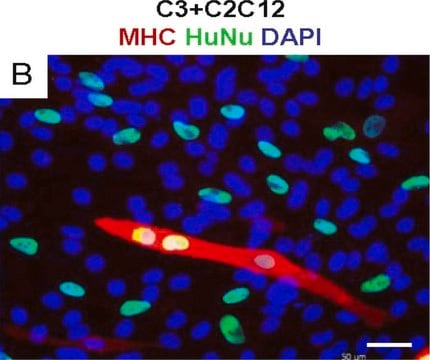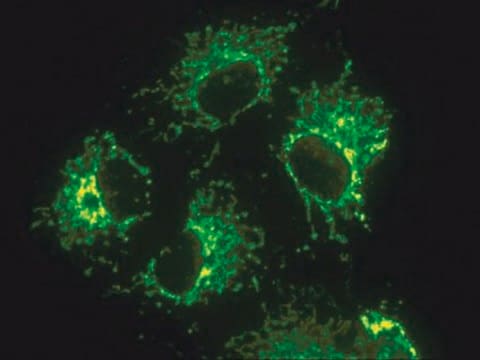MAB1281A4
Anti-Nuclei Antibody, clone 235-1, Alexa Fluor™ 488 conjugate
clone 235-1, from mouse, ALEXA FLUOR™ 488
Synonym(s):
HuNu
Sign Into View Organizational & Contract Pricing
All Photos(4)
About This Item
UNSPSC Code:
12352203
eCl@ss:
32160702
NACRES:
NA.41
Recommended Products
biological source
mouse
Quality Level
conjugate
ALEXA FLUOR™ 488
antibody form
purified immunoglobulin
antibody product type
primary antibodies
clone
235-1, monoclonal
species reactivity
human
technique(s)
immunocytochemistry: suitable
isotype
IgG1
shipped in
wet ice
target post-translational modification
unmodified
General description
Cell replacement techniques such as stem-cell or fetal-cell therapies show great promise for many diseases. Cross-species grafting between human and animal cells or tissues requires the identification and localization of the donor material in the host environment. Antibodies to human-specific nuclei are useful cytological and histological markers for identifying human cells in xenograft models. MAB1281 stains nuclei of all human and primate cell types giving a diffuse nuclear staining pattern. Chromosomes are negatively stained in metaphase cells. The antibody does not react with nuclei from mouse or rat.
Immunogen
Human nuclei
Application
Evaluated by Immunocytochemistry in human bone marrow mesenchymal stem cells (SCR108). Immunocytochemistry Analysis: A 1:100 dilution of this antibody detected nuclei in human bone marrow mesenchymal stem cells (SCR108). Evaluated by Immunocytochemistry in H9 human embryonic stem cells. Immunocytochemistry Analysis: A 1:100 dilution of this antibody detected nuclei in H9 human embryonic stem cells. Evaluated by Immunocytochemistry in mouse embryonic fibroblasts. Immunocytochemistry Analysis: A 1:50 dilution of this antibody did not detect nuclei in mouse embryonic fibroblasts.
Research Category
Stem Cell Research
Stem Cell Research
Stem Cell Research
Stem Cell Research
Research Sub Category
Pluripotent & Early Differentiation
Developmental Neuroscience
Mesenchymal Stem Cells
Neurodegenerative Diseases
Pluripotent & Early Differentiation
Developmental Neuroscience
Mesenchymal Stem Cells
Neurodegenerative Diseases
The anti-Nuclei, clone 235-1, Alexa Fluor 488 conjugate will recognize human cell nuclei only & is usefull in xenograph transplantation studies to study stem cell migration.
Quality
Evaluated by Immunocytochemistry in human foreskin fibroblasts (SCC058). Immunocytochemistry Analysis: A 1:50 dilution of this antibody detected nuclei in human foreskin fibroblasts (SCC058).
Physical form
Protein G Purified
Purified mouse monoclonal IgG1 conjugated to Alexa Fluor™ 488 in PBS with 0.1% sodium azide and 15mg/ml BSA.
Storage and Stability
Maintain refrigerated at 2-8ºC protected from light in undiluted aliquots for up to 6 months from date of receipt.
Analysis Note
Control
Human foreskin fibroblasts (SCC058)
Human foreskin fibroblasts (SCC058)
Other Notes
Concentration: Please refer to the Certificate of Analysis for the lot-specific concentration.
Legal Information
ALEXA FLUOR is a trademark of Life Technologies
Disclaimer
Unless otherwise stated in our catalog or other company documentation accompanying the product(s), our products are intended for research use only and are not to be used for any other purpose, which includes but is not limited to, unauthorized commercial uses, in vitro diagnostic uses, ex vivo or in vivo therapeutic uses or any type of consumption or application to humans or animals.
Not finding the right product?
Try our Product Selector Tool.
Storage Class Code
12 - Non Combustible Liquids
WGK
WGK 2
Flash Point(F)
Not applicable
Flash Point(C)
Not applicable
Certificates of Analysis (COA)
Search for Certificates of Analysis (COA) by entering the products Lot/Batch Number. Lot and Batch Numbers can be found on a product’s label following the words ‘Lot’ or ‘Batch’.
Already Own This Product?
Find documentation for the products that you have recently purchased in the Document Library.
Sacha M L Khong et al.
Stem cells (Dayton, Ohio), 37(2), 240-246 (2018-11-10)
Although bone marrow-derived mesenchymal stem cells (BM-MSCs) are widely recognized as promising therapeutic agents, the age-related impacts on cellular function remain largely uncharacterized. In this study, we found that BM-MSCs from young donors healed wounds in a xenograft model faster
Laura Hidalgo-García et al.
Pharmacological research, 195, 106891-106891 (2023-08-17)
Patients with inflammatory bowel disease (IBD) have a higher risk of developing colitis-associated colorectal cancer (CAC) with poor prognosis. IBD etiology remains undefined but involves environmental factors, genetic predisposition, microbiota imbalance (dysbiosis) and mucosal immune defects. Mesenchymal stromal cell (MSC)
Mikhail Osipovitch et al.
Cell stem cell, 24(1), 107-122 (2018-12-18)
Huntington's disease (HD) is characterized by hypomyelination and neuronal loss. To assess the basis for myelin loss in HD, we generated bipotential glial progenitor cells (GPCs) from human embryonic stem cells (hESCs) derived from mutant Huntingtin (mHTT) embryos or normal
Nadezhda A Evtushenko et al.
International journal of molecular sciences, 22(8) (2021-05-01)
The recessive form of dystrophic epidermolysis bullosa (RDEB) is a crippling disease caused by impairments in the junctions of the dermis and the basement membrane of the epidermis. Using ectopic expression of hTERT/hTERT + BMI-1 in primary cells, we developed
Chunhua Liu et al.
Stem cell research & therapy, 12(1), 376-376 (2021-07-04)
There is a huge controversy about whether xenograft or allograft in the "immune-privileged" brain needs immunosuppression. In animal studies, the prevailing sophisticated use of immunosuppression or immunodeficient animal is detrimental for the recipients, which results in a short lifespan of
Our team of scientists has experience in all areas of research including Life Science, Material Science, Chemical Synthesis, Chromatography, Analytical and many others.
Contact Technical Service







